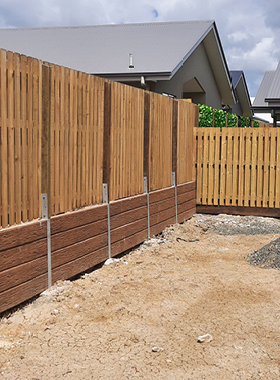Fences and Retaining Walls
Fences and retaining walls are commonly used to separate properties and to retain differences in property levels. Ownership of a dividing fence on a common boundary is shared equally between fence owners. Refer to Neighbourhood Disputes (Dividing Fences and Trees) Act 2011.
The fencing between adjoining properties provides the demarcation and separation of the properties. A common boundary fence is in joint ownership of the abutting property owners. The cost of constructing and maintaining appropriate fencing is the responsibility of the owners of the properties.
Retaining walls serve a different purpose than fences. They are engineered to support built-up or excavated earth. Where a retaining wall is constructed over boundaries and benefits multiple properties, the owners are jointly responsible. Retaining walls should be constructed entirely on one allotment to avoid disputes, including sub-drainage, spoon drainage on the top/at the base of the wall, the footings etc.

-
Prior to building, modifying, or replacing a retaining wall, Council recommends you seek advice from a private building certifier and structural or civil engineer. You must have a building permit before construction, modification, or repair of most retaining walls. Any new retaining wall should be built to last the expected life of the building or property the wall serves.
Retaining walls that need a building approval:
- A permit for building works is required for retaining walls where:
- The wall is 1 metre in height and greater above or below natural ground;
- The wall is located within 1.5 metres of a building or structure and the wall supports the structure (including another retaining wall);
- There is a load imposed above the retaining wall (i.e. driveway, structure or the like).
Modifying a retaining wall includes:- Repairing or replacing more than 20% of the structural components of the retaining wall;
- Adding additional load to the top of the retaining wall. For example; concrete slabs, additional fill, raised garden beds, pools and other structures. These place load on the retaining wall;
- Adding a fence on top of the retaining wall;
- Increasing the height of an existing retaining wall.
-
Yes - drainage is an integral part of retaining walls. The Building Act 1975 (s76) requires that where drainage is part of the approval of the work, it must be carried out in a way that protects land, buildings, and structures in the neighbourhood. If the work is accepted development (i.e. permit is not required), the work must comply with manufacturer specifications (or refer to NMP1.7 of the Queensland Development Code (QDC) for recommended acceptable solutions/performance criteria.
-
Fences up to two metres high above the fence's natural ground surface can generally be built without building approval.
You must have development approval from a private building certifier if your fence:
• Is part of swimming pool fencing;
• Exceeds 2m in height above the fence's natural ground surface;
• Is attached to or located adjacent to a retaining wall requiring approval.Other conditions may apply to your property if it is in a master-planned community or has existing development approvals. These may restrict certain types of fencing. A fence that borders the road reserve must be wholly located within the boundary of the property. A fence, screen, retaining wall or similar structure must allow traffic to have a clear line of vision around the corner when on a corner allotment.
-
A well-designed and constructed fence can provide visual appeal and add value to your property.
Before you build your fence:
• Talk to your neighbours about dividing fences;
• Check your property boundaries;
• Check if you need approval;
• Dial before you dig;
• Get advice if your old fence could contain asbestos.The Neighbourhood Disputes Resolution Act 2011 provides ways for neighbours to resolve disputes about dividing fences. The State Government regulates these matters.
• Speak to your neighbour first. Many people do not realise the problem is occurring and are happy to cooperate.
• See the Department of Justice and Attorney General website for a copy of the Act, forms and FAQs.
• A solicitor can assist with legal considerations between neighbours, including liability and damages.
• If you and your neighbour cannot resolve the problem, the State Justice Department Dispute Resolution Centre can provide mediation without legal action. -
Neighbourhood Disputes (Dividing Fences and Trees) Act
www.legislation.qld.gov.auBuilding Act 1975
www.legislation.qld.gov.auQueensland Development Code QDC – Current Parts
www.hpw.qld.gov.auBuilding Regulation 2021
www.legislation.qld.gov.auQueensland Building and Construction Commission (QBCC)
www.qbcc.qld.gov.au
Click on the link below to view the fences and retaining walls fact sheet:
